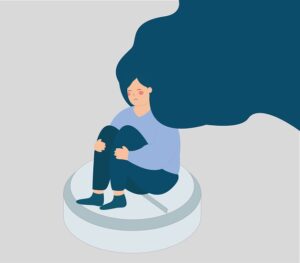Good Grief!

Subscribe to Catalyst
Subscribe to get our magazine delivered right to your inbox
Related Articles
Subscribe to Catalyst
Subscribe to get our magazine delivered right to your inbox
Related Articles
Is there a right way to grieve—and for how long? Bereavement in the age of COVID is getting a re-think.
Ms. B, age 65, has been feeling intense grief after her husband died of a heart attack. Not only is she tearful when remembering how wonderful he was, she avoids specific reminders of him (pictures, places they visited) to prevent even deeper bouts of misery. She is also angry that he died and has recurring thoughts about mistakes she believes his doctor made. In addition, she feels that the church she belongs to can no longer help, since no one can bring her husband back, and often forgets to take her hypertension medication, even though she knows that doing so is dangerous.
Would you consider what Ms. B is going through normal or something to be treated by psychotherapy or medication? Would your answer depend on how long it’s been since she lost her husband?
Since March 2022, as the pandemic’s third wave was setting in, those questions started to hit home with clinicians for the first time. Why? Because it was then that the American Psychiatric Association (APA) officially placed death-related grief into the realm of pathology with its latest revision of the Diagnostic and Statistical Manual of Mental Disorders (DSM-5-TR).
Let’s think about what that means. The DSM is the authority for diagnoses and research on mental disorders in Canada, the U.S., and Australia. Ever since it published the DSM-III in 1980, it has adopted a biomedical-brain disease model, directing psychiatrists and clinical psychologists to see mental disorders in terms of symptoms and illnesses, much like a physician diagnoses physical ailments. Despite the fact that scientists have yet to find “a biological cause of . . . any mental disorder,” it would be difficult to overstate the sway of the DSM’s classifications and diagnostic categories on the way clinicians treat people who come to them for help.
12 million people
Before looking at the APA’s reasons for including death-related grief in the DSM-5-TR — under the name prolonged grief disorder (PGD) — let’s first consider its possible effects in light of COVID-19. The international toll of COVID-19 deaths in September 2022, according to data from Johns Hopkins University, was nearly 6.5 million. With each loss affecting about nine others, (the reverberating effect is known as “bereavement multipliers”), we can expect almost 60 million people to have experienced death-related grief as a result of the virus.
That 6.5 million number is staggering enough in normal times. But restrictions in care facilities, hospitals, and indoor gatherings have made both the usual physical closeness during a loved one’s imminent demise as well as bereavement rituals difficult or impossible. Such isolation has surely added an even greater burden for those left behind in terms of dealing with their loss. The APA itself has said as much, estimating that the usual rate (5-10%) of the more intense and longer grief found in PGD may double in the pandemic context at 20 per cent.
With some fast math, we could estimate PGD afflictions at 12 million people worldwide.
No matter what the final number turns out to be, the pandemic has become doubly relevant to the normalcy or pathology of grief. Given that short-term psychotherapy is currently “the treatment of choice,” the decision to enshrine PGD into the DSM-5 as a psychiatric disorder has and will put unprecedented demands on already overburdened mental health professionals.
Cultural complications
The APA considers PGD a type of trauma- and stressor-related disorder characterized by “intense yearning or longing for the deceased (often with intense sorrow and emotional pain), and preoccupation with thoughts or memories of the deceased.” Because in “normal” grief these experiences generally lose their force over time (6 to 12 months), it says that PGD can be deemed to occur when “the duration of the person’s bereavement “exceeds expected social, cultural or religious norms.” In other words, clinicians should only consider grief symptoms as pathological (that is, subject to diagnosis and treatment) after this period of “expected norms” has run its course.
But will they? Putting such weight on a clinician’s judgment about social, cultural, and religious norms has certainly raised questions. One concern relates to applying a universal secular standard to norms which themselves contain values about healthy and unhealthy grief. Kaori Wada, a registered psychologist and the director of training at the University of Calgary’s counselling psychology program, points to a study involving Canadian undergraduates, which found that religious women participants with experience of bereavement were more likely to see the same grief responses the DSM now deems pathological as healthy.
A second issue is the APA’s adoption of a “normal grief period” in relation to social, cultural, and religious norms. This is something Harvard psychiatrist and medical anthropologist Arthur Kleinman questioned in the Lancet as the DSM-5 was being prepared. As he pointed out, “there is no conclusive scientific evidence to show what a normal length of bereavement is. Across the world, societies differ in what they regard as normal grief.”
Wada likewise stresses the newness of the DSM-5-TR’s “too much for too long” criterion, which is at odds with many cultures and expectations; for instance, those that see honour and moral depth in deliberate, enduring grief and emotional pain. She therefore thinks we should recognize the important shift that happens when we begin to fit what was once “understood outside medical language into a treatable disorder, [using a] ‘diagnose and treat’ logic.” By doing so, she argues, the DSM-5-TR “officializes [the idea] that if you’re grieving too long or too intensely, then you have a mental disorder.”
Wada’s concerns extend to the social, cultural, and religious norms designed to restrain the assessment and treatment of PGD. For her, not only are these norms diverse and complex, they are often far-removed from a psychiatrist’s or therapist’s expertise. In her view, the APA’s instruction to apply them puts a “tremendous amount of weight on the clinician’s shoulders.” And since most people in Canada rely on (short visits to) primary care physicians to address their mental health needs, she doubts whether such assessments are likely to be used very much in practice.
What can we expect when clinicians fail in this task of assessment or else ignore it because they feel ill-prepared? The most likely result would be the erasure of any grace period before recommending therapeutic interventions or dispensing medications.
Take this pill and . . .
While no pharmaceutical treatments for grief have been approved, the research traffic light is blinking bright green. That’s because, when the DSM-5-TR established PGD, the APA also changed complicated grief — a previous diagnostic category left out of the DSM-IV due to insufficient evidence and concerns about overdiagnosis — into persistent complex bereavement disorder (PCBD). While doing so, it also defined PCBD as a condition for further study (rather than a disorder in its own right). Thanks to that change, opportunities for new research were endorsed, including studies to establish medications for PGD.

So far, the leading candidate is naltrexone, currently being used to treat opioid and alcohol use disorders. A number of experts have found this opioid antagonist choice surprising. Indeed, the basis for considering it is the theory that PGD is an addictive condition — in this case, addiction to grief itself. So, as with opioids and alcohol, the purpose of naltrexone is to reduce the grieving person’s connection to the deceased. But since this medication does not discriminate which social connections are affected, psychologists have argued that it’s a mistake to reduce those ties at a time when relations to others are so important. They also emphasize that the pharmacological approach itself neglects the context involved in grief; for instance, the grieving person’s relationship to the deceased, the qualities of that relationship, and the kind of death involved (e.g., natural or unexpected).
Donna Schuurman, who is an expert with years of experience dealing with grief in children, youth, and families in connection with unnatural deaths, offers a less reserved critique, seeing efforts to develop a “grief pill” as entirely removed from the human context: “If you yearn or pine too long for your dead child, partner, spouse, or friend, you may be addicted to grief, according to the new revision of the DSM.” As it turns out, the road that has led to the possibility of a grief pill — while paved with good intentions — includes a rather dramatic shift. But to see it requires a bit of context.
A key element to support the DSM-5-TR’s new position on grief is the role played by major depressive disorder (MDD). MDD was initially distinguished from grief in the 1990s through the work of Holly Prigerson, then a professor at the Harvard department of psychiatry. After noticing the difficulty certain people had in resolving their death-related grief, she and others began arguing that this situation called for a new disorder. The point is that the initial justification for what was to become PGD was the discovery of grief symptoms thought to be distinct from those of MDD.
Remember Ms. B from our opening description? Her case was included in a 2010 paper by Prigerson’s colleagues as a way to offer insight into this distinction, since Ms. B’s mood symptoms failed to meet the criteria for MDD (as did her behaviours for post-traumatic stress disorder [PTSD]).
Yet Wada believes that an argument against overmedication — which Prigerson and her colleagues originally put forward to justify the separation of grief from MDD — has now fallen away. One of their key rationales for this distinction was to “spare [people] from being wrongfully medicated.” But today, with PCBD becoming a condition for further study, some of those same MDD medications that were ineffective for grief are being considered as potential solutions for PGD. While Prigerson herself agrees that antidepressants have not been effective for grief, she thinks it’s important to continue learning more about grief in psychiatric terms to help people in such pain.
The way ahead
Supporters of using medications (perhaps alongside therapy) for those diagnosed with PGD insist that “no one wants to medicalize a normal, adaptive process.” Still, a clinician’s assessment of social, cultural, and religious norms as the sole constraint does not inspire confidence that such an aspiration can be achieved. Nor does the DSM-5’s contentious removal of the “bereavement exclusion” from the DSM-IV — which at least provided a two-month grace period before clinicians were supposed to consider symptoms during death-related grief as major depression. Although these shifts occurred in the name of relieving suffering and concerns over the risk of overlooking such depression, Wada points out that the act of “establishing a disorder category enables, even stimulates, further research into pharmacological interventions.”
While, at the policy level, the crux of the debate may rest on values related to the overuse of medication, the path the DSM-5-TR has cleared for the development of a grief pill is hard to deny. No matter where the APA’s new conception of grief takes us, in light of the millions of vulnerable people experiencing longer and more intense grief due to COVID (or the next mass trauma), this new diagnostic landscape will no doubt itself receive longer and more intense scrutiny.
William Wahl




